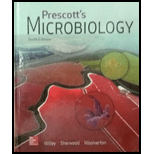
Prescott's Microbiology
10th Edition
ISBN: 9781259281594
Author: Joanne Willey, Linda Sherwood Adjunt Professor Lecturer, Christopher J. Woolverton Professor
Publisher: McGraw-Hill Education
expand_more
expand_more
format_list_bulleted
Textbook Question
Chapter 26, Problem 5CHI
Analysis of sclerotia and conidia formation in the filamentous ascomycete Aspergillus flavus suggests that formation of these structures is cell density dependent. Specifically, high cell density cultures yield conidia, whereas low cell density triggers sclerotia formation. Review the structure and function of conidia and sclerotia, and formulate a hypothesis to explain why their development would be regulated in a density-dependent manner. List several specific testable predictions based on your hypothesis.
Read the original paper: Horowitz-Brown, S., et al. 2008. Morphological transitions governed by density dependence and lipooxygenase activity in Aspergillus flavus. Appl. Environ. Microbiol. 74:5674.
Expert Solution & Answer
Want to see the full answer?
Check out a sample textbook solution
Students have asked these similar questions
Explain in a small summary how:
What genetic information can be obtained from a Punnet square? What genetic information cannot be determined from a Punnet square?
Why might a Punnet Square be beneficial to understanding genetics/inheritance?
In a small summary write down:
Not part of a graded assignment, from a past midterm
Chapter 26 Solutions
Prescott's Microbiology
Ch. 26.1 - Prob. 1RIACh. 26.1 - What is the distribution of these microbes?Ch. 26.1 - Why does the mycelial morphology of fungi make...Ch. 26.1 - Prob. 4RIACh. 26.1 - Prob. 5RIACh. 26.2 - Prob. 1MICh. 26.4 - Prob. 1RIACh. 26.4 - What is the difference between hyphae called...Ch. 26.4 - How do different mating types of Rhizopus...Ch. 26.4 - Prob. 4RIA
Ch. 26.4 - Prob. 5RIACh. 26.5 - What determines when a yeast cell can no longer...Ch. 26.5 - In what ways is the life cycle of filamentous...Ch. 26.5 - Why does nutrient deprivation trigger sexual...Ch. 26.5 - Prob. 2RIACh. 26.5 - Where are you most likely find ascomycetes that...Ch. 26.6 - Prob. 1MICh. 26.7 - Prob. 1RIACh. 26.7 - Prob. 2RIACh. 26.7 - Prob. 3RIACh. 26.7 - Why do you think members of Microsporidia are...Ch. 26 - Compare the nodes and branches that lead to the...Ch. 26 - Prob. 1CHICh. 26 - Prob. 2CHICh. 26 - Prob. 3CHICh. 26 - Prob. 4CHICh. 26 - Analysis of sclerotia and conidia formation in the...
Knowledge Booster
Learn more about
Need a deep-dive on the concept behind this application? Look no further. Learn more about this topic, biology and related others by exploring similar questions and additional content below.Similar questions
- Noggin mutation: The mouse, one of the phenotypic consequences of Noggin mutationis mispatterning of the spinal cord, in the posterior region of the mouse embryo, suchthat in the hindlimb region the more ventral fates are lost, and the dorsal Pax3 domain isexpanded. (this experiment is not in the lectures).a. Hypothesis for why: What would be your hypothesis for why the ventral fatesare lost and dorsal fates expanded? Include in your answer the words notochord,BMP, SHH and either (or both of) surface ectoderm or lateral plate mesodermarrow_forwardNot part of a graded assignment, from a past midtermarrow_forwardNot part of a graded assignment, from a past midtermarrow_forward
- please helparrow_forwardWhat does the heavy dark line along collecting duct tell us about water reabsorption in this individual at this time? What does the heavy dark line along collecting duct tell us about ADH secretion in this individual at this time?arrow_forwardBiology grade 10 study guidearrow_forward
arrow_back_ios
SEE MORE QUESTIONS
arrow_forward_ios
Recommended textbooks for you
 Biology: The Dynamic Science (MindTap Course List)BiologyISBN:9781305389892Author:Peter J. Russell, Paul E. Hertz, Beverly McMillanPublisher:Cengage Learning
Biology: The Dynamic Science (MindTap Course List)BiologyISBN:9781305389892Author:Peter J. Russell, Paul E. Hertz, Beverly McMillanPublisher:Cengage Learning Biology 2eBiologyISBN:9781947172517Author:Matthew Douglas, Jung Choi, Mary Ann ClarkPublisher:OpenStax
Biology 2eBiologyISBN:9781947172517Author:Matthew Douglas, Jung Choi, Mary Ann ClarkPublisher:OpenStax Biology Today and Tomorrow without Physiology (Mi...BiologyISBN:9781305117396Author:Cecie Starr, Christine Evers, Lisa StarrPublisher:Cengage Learning
Biology Today and Tomorrow without Physiology (Mi...BiologyISBN:9781305117396Author:Cecie Starr, Christine Evers, Lisa StarrPublisher:Cengage Learning


Biology: The Dynamic Science (MindTap Course List)
Biology
ISBN:9781305389892
Author:Peter J. Russell, Paul E. Hertz, Beverly McMillan
Publisher:Cengage Learning


Biology 2e
Biology
ISBN:9781947172517
Author:Matthew Douglas, Jung Choi, Mary Ann Clark
Publisher:OpenStax

Biology Today and Tomorrow without Physiology (Mi...
Biology
ISBN:9781305117396
Author:Cecie Starr, Christine Evers, Lisa Starr
Publisher:Cengage Learning

1) Cell Culture Tutorial - An Introduction; Author: Applied Biological Materials - abm;https://www.youtube.com/watch?v=RpDke-Sadzo;License: Standard youtube license